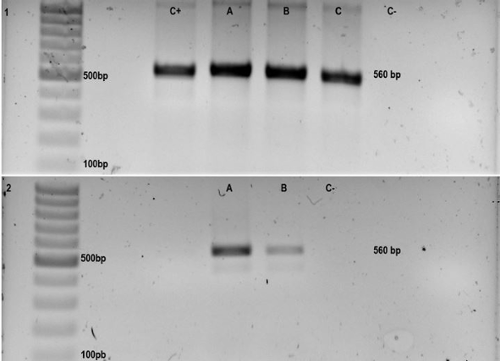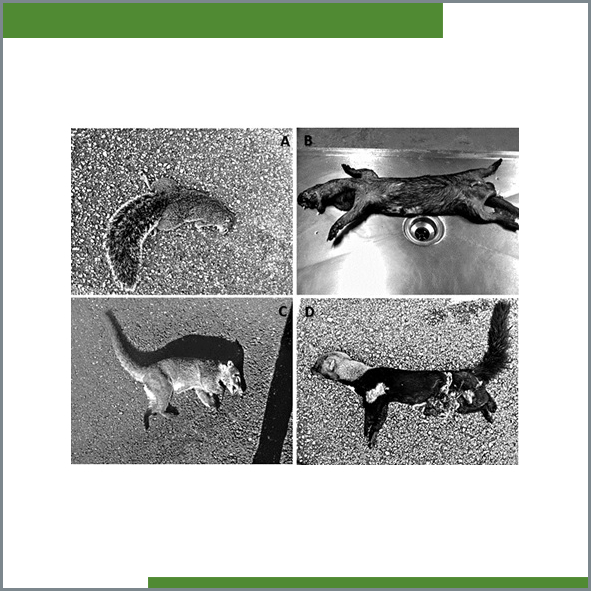Molecular identification of <em>Toxoplasma gondii</em> in roadkill wild animals in Yucatan, Mexico
Contenido principal del artículo
Resumen
Veterinaria México OA
ISSN: 2448-6760
Cite this as:
- Torres-Castro MA, Medina-Pinto RA, Noh-Pech HR, Puerto FI, Rodríguez-Vivas RI. Molecular identification of Toxoplasma gondii in roadkill wild animals in Yucatan, Mexico. Veterinaria México OA. 6(1):2019. doi:10.22201/fmvz.24486760e.2019.1.511.
Toxoplasma gondii is an obligate intracellular protozoan parasite, recognized as the etiologic agent of toxoplasmosis, a zoonotic endemic disease in several countries, including Mexico. In the Yucatan State of Mexico, Toxoplasma infection has a high impact in both human and domestic animal health. Wild animals can also host zoonotic pathogens such as Toxoplasma gondii. The presence of Toxoplasma gondii DNA in roadkill wild animals in Yucatan was detected using a nested Polymerase Chain Reaction. Toxoplasma gondii DNA was identified in several organs retrieved from a Yucatan squirrel (Sciurus yucatanensis), a coatimundi (Nasua narica), and a greater grison (Galictis vittata). The amplified fragments of Toxoplasma gondii DNA were purified, sequenced, and certified by BLAST analysis. Our results confirm that Toxoplasma gondii can infect wild mammals from Yucatan, which could act as intermediate hosts and contribute to the transmission of the disease to humans and domestic animals, as well as other wild animal species. We present the first molecular evidence of Toxoplasma gondii in a squirrel and a coatimundi from Yucatan, and quite possibly in a greater grison at a global level.

Figure 1. Agarose gel presenting PCR amplicons (560 bp) positive to Toxoplasma gondii. 1) C+: positive control; A: Yucatan squirrel liver sample; B: great grison femoral muscle sample; C: coatimundi kidney sample; C-: negative control. 2) A: Yucatan squirrel brain sample; B: great grison lung sample; C-: negative control.
Detalles del artículo
Citas
Weiss LM, Dubet JP. Toxoplasmosis: a history of clinical observations. Int J Para¬sitol. 2009;39:895-901. doi: 10.1016/j.ijpara.2009.02.004.
Dubey JP. Toxoplasmosis of animals and humans. Boca Raton, FL: CRC Press; 2010.
Turčeková Ľ, Hurníková Z, Spišák F, Miterpáková M, Chovancová B. Toxoplasma gondii in protected wildlife in the Tatra National Park (TANAP), Slovakia. Ann Agric Environ Med. 2014;21:235-8. doi: 10.5604/1232-1966.1108582.
Palmezano-Díaz JM, Plazas-Rey LK, Rojas-Carvajal D. Infección por Toxoplasma: panorama actual. Spei Domus. 2015;11:47-56. doi: 10.16925/sp.v11i22.1154.
Chen R, Lin X, Hu L, Chen X, Tang Y, Zhang J, et al. Genetic characterization of Toxoplasma gondii from zoo wildlife and pet birds in Fujian, China. Iran J Para¬sitol. 2015;10:663-8.
Thompson RC. Parasite zoonoses and wildlife: one health, spillover and human activity. Int J Parasitol. 2013;43:1079-88. doi: 10.1016/j.ijpara.2013.06.007.
Hernández-Cortazar I, Acosta-Viana KY, Ortega-Pacheco A, Guzmán-Marín ES, Aguilar-Caballero AJ, Jiménez-Coello M. Toxoplasmosis in Mexico: epidemiologi¬cal situation in humans and animals. Rev Inst Med Trop São Paulo. 2015;57:93- 103. doi: 10.1590/S0036-46652015000200001.
Reid FA. A field guide to the mammals of Central America and Southeast Mexi¬co. New York: Oxford University Press; 1997.
Jalal S, Nord CE, Lappalainen M, Evengård B, ESCMID Study Group on Toxoplas¬mosis. Rapid and sensitive diagnosis of Toxoplasma gondii infections by PCR. Clin Microbiol Infect. 2004;10:937-9.
Tamura K, Peterson D, Peterson N, Stecher G, Nei M, Kumar S. MEGA5: mo¬lecular evolutionary genetics analysis using maximum likelihood, evolutionary distance, and maximum parsimony methods. Mol Biol Evol. 2011;28:2731-9. doi: 10.1093/molbev/msr121.
Saitou N, Nei M. The neighbor-joining method: a new method for reconstructing phylogenetic trees. Mol Biol Evol. 1987;4:406-25.
Felsenstein J. Confidence limits on phylogenies: an approach using the boot¬strap. Evolution. 1985;39:783-91. doi: 10.1111/j.1558-5646.1985.tb00420.x.
Richini-Pereira RP, Marson PM, Costa-da Silva R, Langoni H. Genotyping of Toxo¬plasma gondii and Sarcocystis spp. in road-killed wild mammals from the Cen¬tral Western Region of the State of São Paulo, Brazil. Rev Soc Bras Med Trop. 2016;49:602-7. doi: 10.1590/0037-8682-0270-2016.
Castillo-Morales VJ, Acosta-Viana KY, Guzmán-Marín ES, Jiménez-Coello M, Segu¬ra-Correa JC, Aguilar-Caballero AJ, Ortega-Pacheco A. Prevalence and risk factors of Toxoplasma gondii in domestic cats from the tropics of Mexico using sero¬logical and molecular tests. Interdiscip Perspect Infect Dis. 2012;2012:529108.
Ortega-Pacheco A, Acosta-Viana KY, Guzmán-Marín E, Segura-Correa JC, Álva¬rez-Fleites M, Jiménez-Coello M. Prevalence and risk factor of Toxoplasma gondii in fattening pigs farm from Yucatan, Mexico. Biomed Res Int. 2013;2013;231497. doi: 10.1155/2013/231497.
Hernández-Cortazar IB, Acosta-Viana KI, Guzmán-Marín E, Ortega-Pacheco A, Torres-Acosta JF, Jiménez-Coello M. Presence of Toxoplasma gondii in pork intended for human consumption in tropical Southern of Mexico. Foodborne Pathog Dis. 2016;13:695-9.
Torres-Castro M, Noh-Pech H, Puerto-Hernández R, Reyes-Hernández B, Panti- May A, Hernández-Betancourt S, et. al. First molecular evidence of Toxoplasma gondii in opossums (Didelphis virginiana) from Yucatan, Mexico. Open Vet J. 2016a;6:57-61. doi: org/10.4314/ovj.v6i1.8.
Torres-Castro MA, Medina-Espinosa DN, Panti-May JA, Hernández-Betancourt SF, Noh-Pech HR, Yeh-Gorocica AB, et. al. First molecular evidence of Toxoplas¬ma gondii in synanthropic rodents (Mus musculus and Rattus rattus) captured in Yucatan, Mexico. Revue Méd Vét. 2016b;167:250-5.
Zavala-Velázquez J, Guzmán-Marín E, Barrera-Pérez M, Rodríguez-Félix ME. Toxo¬plasmosis and abortion in patients at the O’Horan Hospital of Merida, Yucatan. Salud Publica Mex. 1989;31:664-8.
Góngora-Biachi RA, González-Martínez P, Castro-Sansores C, Pavía-Ruz N, Lara-Perera D, Alonzo-Salomón G, et al. Anticuerpos contra Toxoplasma gondii en pacientes con VIH en Yucatán. Rev Invest Clin. 1998;50:419-22.
Jiménez-Coello M, Guzmán-Marín E, Ortega-Pacheco A, Acosta-Viana KY. Immu¬nological status against Toxoplasma gondii in non-cat owners from an endemic region of Mexico. Vector Borne Zoonotic Dis. 2011;11:1057-61. doi: 10.1089/ vbz.2010.0111.
Vado-Solís IA, Suárez-Solís VM, Jiménez-Delgadillo B, Zavala-Velázquez JE, Se¬gura JC. Toxoplasma gondii presence in women with spontaneous abortion in Yucatan, Mexico. J Parasitol. 2013;99:383-5. doi: 10.1645/GE-3189.1.
Hernández-Cortazar IB, Acosta-Viana KI, Guzmán-Marín E, Ortega-Pacheco A, Segura-Correa JC, Jiménez-Coello M. Presence of Toxoplasma gondii in drink¬ing water from an endemic region in Southern Mexico. Foodborne Pathog Dis. 2017;14:288-92. doi: 10.1089/fpd.2016.2224.
Herrmann DC, Maksimov P, Maksimov A, Sutor A, Schwarz S, Jaschke W, et al. Toxoplasma gondii in foxes and rodents from the German Federal States of Brandenburg and Saxony-Anhalt: seroprevalence and genotypes. Vet Parasitol. 2012;185:78-85. doi: 10.1016/j.vetpar.2011.10.030.
Fayyad A, Kummerfeld M, Davina I, Wohlsein P, Beineke A, Baumgärtner W, et al. Fatal systemic Toxoplasma gondii infection in a red squirrel (Sciurus vul¬garis), a Swinhoe’s striped squirrel (Tamiops swinhoei) and a New World porcupine (Erethizontidae sp.). J Comp Pathol. 2016;154:263-7. doi: 10.1016/j. jcpa.2016.02.002.
Kik M, IJzer J, Opsteegh M, Montizaan M, Dijkstra V, Rijks J, et al. Toxoplas¬ma gondii in wild red squirrels, the Netherlands, 2014. Emerg Infect Dis. 2015;21:2248-9. doi: 10.3201/eid2112.141711.
Jokelainen P, Nylund M. Acute fatal toxoplasmosis in three Eurasian red squir¬rels (Sciurus vulgaris) caused by genotype II of Toxoplasma gondii. J Wildl Dis. 2012;48:454-7.
Suzán G, Ceballos G. The role of feral mammals on wildlife infectious disease prevalence in two nature reserves within Mexico City limits. J Zoo Wildl Med. 2005;36:479-84.
Robert-Gangneux F. It is not only the cat that did it: how to prevent and treat congenital toxoplasmosis. J Infect. 2014;68 Suppl 1:S125-33. doi: 10.1016/j. jinf.2013.09.023.
Alvarado-Esquivel C, Cruz-Magallanes HM, Esquivel-Cruz R, Estrada-Martínez S, Rivas-González M, Liesenfeld O, et al. Seroepidemiology of Toxoplasma gondii infection in human adults from three rural communities in Durango State, Mex¬ico. J Parasitol. 2008;94:811-6. doi: 10.1645/GE-1524.1.
Khan A, Ajzenberg D, Mercier A, Demar M, Simon S, Dardé ML, et al. Geo¬graphic separation of domestic and wild strains of Toxoplasma gondii in French Guiana correlates with a monomorphic version of chromosome1a. PLoS Negl Trop Dis. 2014;8:e3182. doi: 10.1371/journal.pntd.0003182.
Rendón-Franco E, Caso A, Jiménez-Sánchez NG, Carvajal-Villareal S, Zepe¬da-López H. Frequency of antibodies against Toxoplasma gondii in wild carni¬vores and marsupials in northeast Mexico. Neotrop Helminthol. 2014;8:473-8.
Tlapaya L, Gallina S. Cacería de mamíferos medianos en cafetales del centro de Veracruz, México. Acta Zool Mex. 2010;26:259-77.
License

Veterinaria México OA por Facultad de Medicina Veterinaria y Zootecnia de la Universidad Nacional Autónoma de México se distribuye bajo una Licencia Creative Commons Atribución 4.0 Internacional.
Basada en una obra en http://www.revistas.unam.mx
- Todos los artículos en Veterinaria México OA se publican bajo una licencia de Creative Commons Reconocimiento 4.0 Unported (CC-BY 4.0). Con esta licencia, los autores retienen el derecho de autor, pero permiten a cualquier usuario compartir, copiar, distribuir, transmitir, adaptar y hacer uso comercial de la obra sin necesidad de proporcionar un permiso adicional, siempre y cuando se otorgue el debido reconocimiento al autor o fuente original.
- Al utilizar esta licencia, los artículos en Veterinaria México OA cubren o exceden todos los requisitos fundacionales e institucionales para ser considerados de Acceso Abierto.
- Los autores no pueden utilizar material protegido por derechos de autor en su artículo a menos que ese material esté también disponible bajo una licencia igualmente generosa.







